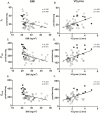Chronological Age Does not Influence Ex-vivo Mitochondrial Respiration and Quality Control in Skeletal Muscle
- PMID: 27325231
- PMCID: PMC6075361
- DOI: 10.1093/gerona/glw102
Chronological Age Does not Influence Ex-vivo Mitochondrial Respiration and Quality Control in Skeletal Muscle
Abstract
Background: Considerable debate continues to surround the concept of mitochondrial dysfunction in aging muscle. We tested the overall hypothesis that age per se does not influence mitochondrial function and markers of mitochondria quality control, that is, expression of fusion, fission, and autophagy proteins. We also investigated the influence of cardiorespiratory fitness (VO2max) and adiposity (body mass index) on these associations.
Methods: Percutaneous biopsies of the vastus lateralis were obtained from sedentary young (n = 14, 24±3 years), middle-aged (n = 24, 41±9 years) and older adults (n = 20, 78±5 years). A physically active group of young adults (n = 10, 27±5 years) was studied as a control. Mitochondrial respiration was determined in saponin permeabilized fiber bundles. Fusion, fission and autophagy protein expression was determined by Western blot. Cardiorespiratory fitness was determined by a graded exercise test.
Results: Mitochondrial respiratory capacity and expression of fusion (OPA1 and MFN2) and fission (FIS1) proteins were not different among sedentary groups despite a wide age range (21 to 88 years). Mitochondrial respiratory capacity and fusion and fission proteins were, however, negatively associated with body mass index, and mitochondrial respiratory capacity was positively associated with cardiorespiratory fitness. The young active group had higher respiration, complex I and II respiratory control ratios, and expression of fusion and fission proteins. Finally, the expression of fusion, fission, and autophagy proteins were linked with mitochondrial respiration.
Conclusions: Mitochondrial respiration and markers of mitochondrial dynamics (fusion and fission) are not associated with chronological age per se, but rather are more strongly associated with body mass index and cardiorespiratory fitness.
Keywords: Aging; Body composition; Mitochondria; Muscle; Physical activity.
© The Author 2016. Published by Oxford University Press on behalf of The Gerontological Society of America. All rights reserved. For permissions, please e-mail: journals.permissions@oup.com.
Figures




References
-
- Gouspillou G, Sgarioto N, Kapchinsky S, et al. Increased sensitivity to mitochondrial permeability transition and myonuclear translocation of endonuclease G in atrophied muscle of physically active older humans. FASEB J. 2014;28:1621–1633. doi:10.1096/fj.13-242750 - PubMed
MeSH terms
Grants and funding
LinkOut - more resources
Full Text Sources
Other Literature Sources

